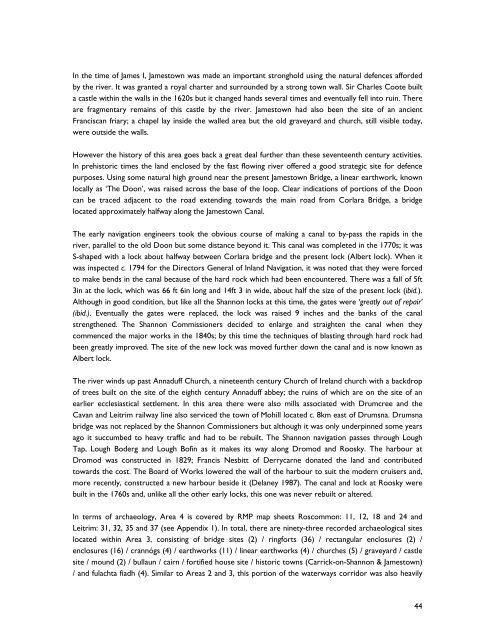archaeological & built heritage assessment - The Heritage Council
archaeological & built heritage assessment - The Heritage Council
archaeological & built heritage assessment - The Heritage Council
Create successful ePaper yourself
Turn your PDF publications into a flip-book with our unique Google optimized e-Paper software.
In the time of James I, Jamestown was made an important stronghold using the natural defences afforded<br />
by the river. It was granted a royal charter and surrounded by a strong town wall. Sir Charles Coote <strong>built</strong><br />
a castle within the walls in the 1620s but it changed hands several times and eventually fell into ruin. <strong>The</strong>re<br />
are fragmentary remains of this castle by the river. Jamestown had also been the site of an ancient<br />
Franciscan friary; a chapel lay inside the walled area but the old graveyard and church, still visible today,<br />
were outside the walls.<br />
However the history of this area goes back a great deal further than these seventeenth century activities.<br />
In prehistoric times the land enclosed by the fast flowing river offered a good strategic site for defence<br />
purposes. Using some natural high ground near the present Jamestown Bridge, a linear earthwork, known<br />
locally as ‘<strong>The</strong> Doon’, was raised across the base of the loop. Clear indications of portions of the Doon<br />
can be traced adjacent to the road extending towards the main road from Corlara Bridge, a bridge<br />
located approximately halfway along the Jamestown Canal.<br />
<strong>The</strong> early navigation engineers took the obvious course of making a canal to by-pass the rapids in the<br />
river, parallel to the old Doon but some distance beyond it. This canal was completed in the 1770s; it was<br />
S-shaped with a lock about halfway between Corlara bridge and the present lock (Albert lock). When it<br />
was inspected c. 1794 for the Directors General of Inland Navigation, it was noted that they were forced<br />
to make bends in the canal because of the hard rock which had been encountered. <strong>The</strong>re was a fall of 5ft<br />
3in at the lock, which was 66 ft 6in long and 14ft 3 in wide, about half the size of the present lock (ibid.).<br />
Although in good condition, but like all the Shannon locks at this time, the gates were ‘greatly out of repair’<br />
(ibid.). Eventually the gates were replaced, the lock was raised 9 inches and the banks of the canal<br />
strengthened. <strong>The</strong> Shannon Commissioners decided to enlarge and straighten the canal when they<br />
commenced the major works in the 1840s; by this time the techniques of blasting through hard rock had<br />
been greatly improved. <strong>The</strong> site of the new lock was moved further down the canal and is now known as<br />
Albert lock.<br />
<strong>The</strong> river winds up past Annaduff Church, a nineteenth century Church of Ireland church with a backdrop<br />
of trees <strong>built</strong> on the site of the eighth century Annaduff abbey; the ruins of which are on the site of an<br />
earlier ecclesiastical settlement. In this area there were also mills associated with Drumcree and the<br />
Cavan and Leitrim railway line also serviced the town of Mohill located c. 8km east of Drumsna. Drumsna<br />
bridge was not replaced by the Shannon Commissioners but although it was only underpinned some years<br />
ago it succumbed to heavy traffic and had to be re<strong>built</strong>. <strong>The</strong> Shannon navigation passes through Lough<br />
Tap, Lough Boderg and Lough Bofin as it makes its way along Dromod and Roosky. <strong>The</strong> harbour at<br />
Dromod was constructed in 1829; Francis Nesbitt of Derrycarne donated the land and contributed<br />
towards the cost. <strong>The</strong> Board of Works lowered the wall of the harbour to suit the modern cruisers and,<br />
more recently, constructed a new harbour beside it (Delaney 1987). <strong>The</strong> canal and lock at Roosky were<br />
<strong>built</strong> in the 1760s and, unlike all the other early locks, this one was never re<strong>built</strong> or altered.<br />
In terms of archaeology, Area 4 is covered by RMP map sheets Roscommon: 11, 12, 18 and 24 and<br />
Leitrim: 31, 32, 35 and 37 (see Appendix 1). In total, there are ninety-three recorded <strong>archaeological</strong> sites<br />
located within Area 3, consisting of bridge sites (2) / ringforts (36) / rectangular enclosures (2) /<br />
enclosures (16) / crannógs (4) / earthworks (11) / linear earthworks (4) / churches (5) / graveyard / castle<br />
site / mound (2) / bullaun / cairn / fortified house site / historic towns (Carrick-on-Shannon & Jamestown)<br />
/ and fulachta fiadh (4). Similar to Areas 2 and 3, this portion of the waterways corridor was also heavily<br />
44
















